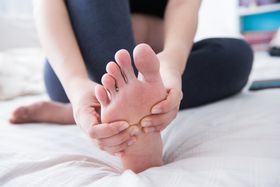Heel Pain: How Achilles Tendonitis and Plantar Fasciitis Differ
Updated December 20, 2024

Achilles tendonitis and plantar fasciitis are two common causes of pain in the foot and are frequently confused. This is because they both cause pain in the heels, with similar symptoms that worsen when weight is placed on the leg and foot.
However, there is a stark difference between these conditions. Chief among these differences is the location of pain and the aggravating factors.
Let’s find out more about each condition and how they compare.
What Is Achilles Tendonitis?
Achilles tendonitis is a chronic overuse injury of the Achilles tendon—the band of tissue that links the calf muscles to the heel bone. It is caused by placing excess strain on the Achilles tendon. Depending on where the strain occurs, you can have insertional tendonitis or non-insertional Achilles tendonitis.
What Is Plantar Fasciitis?
Plantar fasciitis is the inflammation of the plantar fascia—the band of connective tissue that runs from the ball of the foot to the heel.
Differences Between Achilles Tendonitis and Plantar Fasciitis
Although Achilles tendonitis and plantar fasciitis both cause heel pain, there are vast differences between the two based on their causes, presentation of symptoms, treatment, and recovery.
Causes
Achilles tendonitis is caused by excess strain from being overweight or a sudden increase in intensity and duration of exercises and other physical activities. It may also be due to training with improper shoes, on uneven surfaces, or without warmup. Being overweight, male, and over 30 can also increase your risk of developing Achilles tendonitis.
Plantar fasciitis occurs as a result of prolonged strain on the feet from overuse or overstretching of the fascia. Plantar fasciitis is a major cause of pain in the heel.
Symptoms
Achilles tendonitis causes sharp, aching pain around the heel bone. Related symptoms like tenderness, swelling, loss of range of motion, and tight or weak calf muscles may also occur.
Plantar fasciitis causes a stabbing pain in the heel. The pain is often restricted to the area around the heel, although it may also spread to the toes.
While Achilles tendon pain is most intense during activity, plantar fasciitis causes the most pain immediately after rest or activity.
Treatment
The main reason you need to accurately determine if you have Achilles tendonitis or plantar fasciitis is that the ways to treat and manage the conditions differ.
With Achilles tendonitis, home treatments (rest, ice, use of NSAIDs, etc.) can help with pain relief. However, exercise (strengthening, balance, and plyometric exercises) and activity modification are the most effective management methods. Exercises aim to improve the strength of the calf muscles. Orthotics that are placed under the heel can also be used.
Similarly, plantar fasciitis can be managed with home treatment and other conservative treatment approaches. It differs, however, as the exercises aim to stretch the foot arch, and insoles will offer arch support. Shock wave therapy can also be used to stimulate the healing of damaged tissues.
For both conditions, if there is no improvement despite conservative management, surgery may be necessary.
Recovery Time
Once either condition is diagnosed, it is best to begin intervention immediately as both conditions can lead to back, hip, and knee problems. They can also cause gait abnormality and lead to several other complications.
Full recovery after Achilles tendonitis will take 3–12 months, even with surgery.
The healing time for plantar fasciitis is faster with surgery (3–4 months) but longer (6–18 months) without surgery.
Can You Have Achilles Tendonitis and Plantar Fasciitis at the Same Time?
Despite all the differences between the two conditions, you can suffer both simultaneously. In fact, it is called plantar tendonitis when both conditions occur together.
The interrelationship is not surprising, as both structures work together to ensure forward motion. For example, tight calf muscles will make the Achilles tendon taut. A tight Achilles will strain the plantar fascia as the pull will transfer from the Achilles tendon to the fascia.
Orthotics for plantar fasciitis and orthotic insoles for Achilles tendonitis present an excellent way to manage both conditions. These orthotics must possess a firm but cushioned arch support to protect the heel and reduce the strain on the Achilles tendon and plantar fascia. So even if you have both Achilles tendonitis and plantar fasciitis concurrently, custom orthotics can help improve both conditions immediately.








